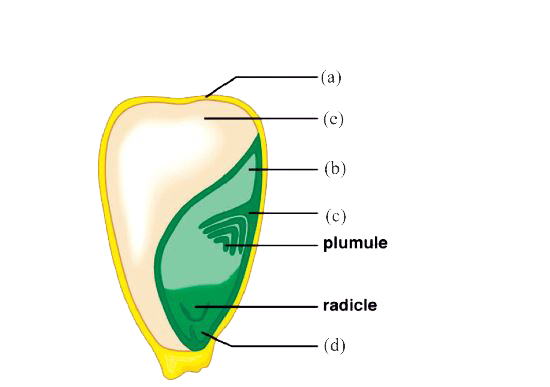Discuss structure of monocotyledonous embryo.
Step-by-Step Solution:
1. Introduction to Monocotyledonous Embryo:
- The monocotyledonous embryo develops from a zygote, which is formed through the process of fertilization.
2. Formation of the Embryo:
- After fertilization, the zygote undergoes division, leading to the formation of the embryo.
3. Characteristics of Monocots:
- Monocots are characterized by having a single cotyledon, in contrast to dicots, which have two cotyledons.
4. Cotyledon in Monocots:
- The single cotyledon in monocots is referred to as the scutellum. It is located on one side of the embryonal axis, specifically on the lateral side.
5. Embryonal Axis:
- The embryonal axis has a lower end that features the radical, which will develop into the root.
6. Protective Sheath for Radical:
- The radical is covered by a protective sheath known as the cauliorrhiza.
7. Plumule and Shoot Apex:
- On the opposite side of the radical, there is the plumule, which is the part of the embryonal axis above the attachment point of the scutellum. This region is called the epicotyl.
8. Protective Sheath for Plumule:
- The plumule is protected by another sheath called the coleoptile, which covers the shoot apex.
9. Summary of Structure:
- In summary, the structure of a monocotyledonous embryo includes:
- One cotyledon (scutellum)
- Radical (root)
- Cauliorrhiza (protective sheath for radical)
- Plumule (shoot)
- Epicotyl (region above scutellum)
- Coleoptile (protective sheath for plumule)
- The monocotyledonous embryo develops from a zygote, which is formed through the process of fertilization.
- After fertilization, the zygote undergoes division, leading to the formation of the embryo.
- Monocots are characterized by having a single cotyledon, in contrast to dicots, which have two cotyledons.
- The single cotyledon in monocots is referred to as the scutellum. It is located on one side of the embryonal axis, specifically on the lateral side.
- The embryonal axis has a lower end that features the radical, which will develop into the root.
- The radical is covered by a protective sheath known as the cauliorrhiza.
- On the opposite side of the radical, there is the plumule, which is the part of the embryonal axis above the attachment point of the scutellum. This region is called the epicotyl.
- The plumule is protected by another sheath called the coleoptile, which covers the shoot apex.
- In summary, the structure of a monocotyledonous embryo includes:
- One cotyledon (scutellum)
- Radical (root)
- Cauliorrhiza (protective sheath for radical)
- Plumule (shoot)
- Epicotyl (region above scutellum)
- Coleoptile (protective sheath for plumule)
Topper's Solved these Questions
- SEXUAL REPRODUCTION IN FLOWERING PLANTSBOOK - MODERN PUBLICATIONCHAPTER - SEXUAL REPRODUCTION IN FLOWERING PLANTSEXERCISE - Revison Exercises (VI. Long Answer Type Questions)
25 Videos
- SEXUAL REPRODUCTION IN FLOWERING PLANTSBOOK - MODERN PUBLICATIONCHAPTER - SEXUAL REPRODUCTION IN FLOWERING PLANTSEXERCISE - Competition File (Objective Type Questions (MCQ))
89 Videos
- SEXUAL REPRODUCTION IN FLOWERING PLANTSBOOK - MODERN PUBLICATIONCHAPTER - SEXUAL REPRODUCTION IN FLOWERING PLANTSEXERCISE - Revison Exercises (B. (Questions From Cbse Board Examinations)
19 Videos
- REPRODUCTIVE HEALTH BOOK - MODERN PUBLICATIONCHAPTER - REPRODUCTIVE HEALTH EXERCISE - CHAPTER PRACTICE TEST (SECTION D (LONG ANSWER QUESTION))
2 Videos
- STRATEGIES FOR ENHANCEMENT IN FOOD PRODUCTIONBOOK - MODERN PUBLICATIONCHAPTER - STRATEGIES FOR ENHANCEMENT IN FOOD PRODUCTIONEXERCISE - CHAPTER PRACTICE TEST
15 Videos
Similar Questions
Knowledge Check
In monocotyledonous stem
AEpidermis is covered with a thick cuticle and bears a few stomata.BThe cells of hypodermis are collenchymatous.CGround tissue consists of rounded parenchymatous cells without intercellular spacesDThe vascular bundles are many in number and are of same size.The following diagram is the typical structure of monocotyledonous seeds. Identify all the five parts, A, B,C,D and E
 AA - Embryo, B - Endosperm, C - Scutellum, D- Coleorrhiza, E- ColeoptileBA - Endosperm, B - Embryo, C - Scutellum, D- Coleoptile, E- ColeorrhizaCA - Embryo, B - Endosperm, C - Scutellum, D - Coleoptile, E - ColerrhizaDA - Endosperm, B - Embryo, C- Scutellum, D - Coleorrhiza, E - Coleoptile
AA - Embryo, B - Endosperm, C - Scutellum, D- Coleorrhiza, E- ColeoptileBA - Endosperm, B - Embryo, C - Scutellum, D- Coleoptile, E- ColeorrhizaCA - Embryo, B - Endosperm, C - Scutellum, D - Coleoptile, E - ColerrhizaDA - Endosperm, B - Embryo, C- Scutellum, D - Coleorrhiza, E - ColeoptileBelow is the diagram of a typical structure of monocotyledonous seeds. In which one of the options all the five" parts A, B, C, D and E are correct?
 AA-Endosperm, B - Embryo, C- Scutellum, D - Coleorrhiza, E-ColeoptileBA-Endosperm, B-Scutellum, C- Embryo, D - Coleoptile, E-ColeorrhizaCA-Endosperm, B-Embryo, C- Scutellum, D - Coleoptile, E- ColeorrhizaDA-Embryo, B-Endosperm, C- Scutellum, D - Coleorrhiza, E-Coleoptile
AA-Endosperm, B - Embryo, C- Scutellum, D - Coleorrhiza, E-ColeoptileBA-Endosperm, B-Scutellum, C- Embryo, D - Coleoptile, E-ColeorrhizaCA-Endosperm, B-Embryo, C- Scutellum, D - Coleoptile, E- ColeorrhizaDA-Embryo, B-Endosperm, C- Scutellum, D - Coleorrhiza, E-Coleoptile
Structure Of A Monocotyledonous Seed
View SolutionMonocotyledonous Root
View SolutionDescribe the structure of a typical dicotyledonous embryo.
View SolutionIn the given structure of a Monocotyledonous seed label the parts a, b, c, d, e. Give the function of part ‘a’.

View SolutionMonocotyledonous stem has
View Solution
